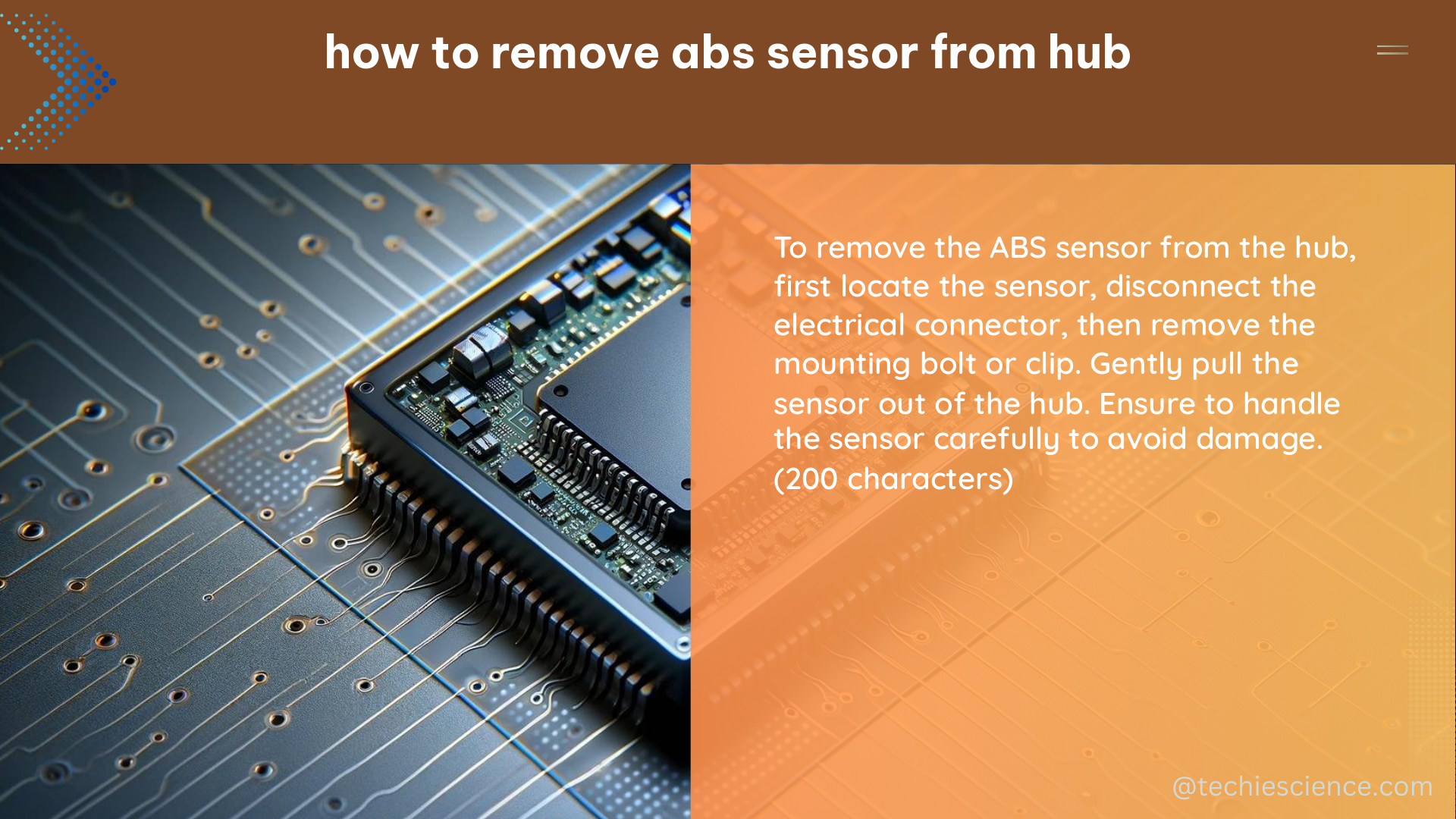Removing an ABS (Anti-lock Braking System) sensor from a hub can be a delicate task, but with the right knowledge and tools, it can be done efficiently. This comprehensive guide will walk you through the process step-by-step, providing you with the technical details and specifications you need to ensure a successful sensor removal.
Sensor Design and Operating Principle
ABS sensors are designed to detect the rotation of the impulse wheel, which is connected to the wheel hub or drive shaft. The sensor consists of a pole pin surrounded by a winding that connects to a permanent magnet. As the impulse wheel rotates, the changing magnetic field induces a quantifiable alternating voltage in the winding. This voltage is proportional to the wheel speed and can be measured to determine the vehicle’s speed.
The sensor’s operating principle is based on the Hall effect, where the movement of a conductive material (the impulse wheel) through a magnetic field generates an electrical voltage. The sensor’s winding converts this voltage into a digital signal that the vehicle’s electronic control unit (ECU) can interpret and use to control the ABS system.
Connection to Vehicle Electronic Systems

ABS sensors are connected to the vehicle’s ECU via a wiring harness. The ECU uses the sensor data to control the ABS system and other driving assistance systems, such as Traction Control System (TCS), Electronic Stability Program (ESP), or Adaptive Cruise Control (ACC). The sensor data is also provided to other systems, such as the engine, transmission, navigation, and chassis control systems, via data lines.
The sensor’s connection to the ECU is crucial, as any issues with the wiring or sensor itself can lead to ABS-related problems, such as the ABS warning light illuminating on the dashboard or the ABS system not functioning correctly.
Removal Process
To remove an ABS sensor from a hub, you will need to follow these steps:
- Disconnect the Wiring Harness:
- Locate the wiring harness connector that is connected to the ABS sensor.
- Use a small flathead screwdriver to release the locking tab on the connector and gently disconnect it from the sensor.
-
Be careful not to damage the connector or the wiring harness during the disconnection process.
-
Unscrew the Sensor:
- Identify the screws that secure the ABS sensor to the hub.
- Using the appropriate screwdriver (typically a Torx or hex head screwdriver), unscrew the sensor from the hub.
-
The sensor is typically secured with one or two screws, but the number and type of screws may vary depending on the vehicle model.
-
Clean the Sensor and Hub Surface:
- Use a clean, lint-free cloth and an appropriate cleaning solution to thoroughly clean the ABS sensor and the hub surface.
-
Removing any dirt, debris, or corrosion from these surfaces will ensure a good connection when the new sensor is installed.
-
Install the New Sensor:
- Reverse the above steps to install the new ABS sensor.
- Make sure the sensor is securely fastened to the hub, and the wiring harness is properly connected.
- Ensure that the sensor is aligned correctly and that there is no interference with the impulse wheel.
Technical Specifications
Here are the key technical specifications for ABS sensors:
- Sensor Type: Hall effect sensor
- Sensor Voltage: Typically 5-12 VDC
- Output Signal: Alternating voltage, proportional to wheel speed
- Frequency Range: Typically 0.5 Hz to 10 kHz
- Impulse Wheel Teeth: Typically 40-100 teeth
- Sensor Mounting: Secured to the hub with one or two screws
- Wiring Harness: Connected to the vehicle’s ECU via a multi-pin connector
It’s important to note that the specific technical specifications may vary depending on the vehicle make, model, and year, as well as the sensor manufacturer. Always refer to the vehicle’s service manual or the sensor manufacturer’s documentation for the most accurate and up-to-date information.
References
- DEPARTMENT OF DEFENSE SMALL BUSINESS INNOVATION RESEARCH (SBIR) BAA 242 – FY2024. https://www.dodsbirsttr.mil/submissions/api/public/download?fileName=DOD_SBIR_242_FULL.pdf&showOnWeb=true&uploadId=MTM3NTM2NA%3D%3D
- Check and change ABS and wheel speed sensors – HELLA. https://www.hella.com/techworld/us/Technical/Sensors-and-actuators/Check-change-ABS-sensor-4074/
- 2023 Iveco Group Sustainability Report. https://www.ivecogroup.com/sustainability/-/media/sustainability/publications/sustainability_report/docs/2023_Iveco_Group_Sustainability_Report.pdf

The lambdageeks.com Core SME Team is a group of experienced subject matter experts from diverse scientific and technical fields including Physics, Chemistry, Technology,Electronics & Electrical Engineering, Automotive, Mechanical Engineering. Our team collaborates to create high-quality, well-researched articles on a wide range of science and technology topics for the lambdageeks.com website.
All Our Senior SME are having more than 7 Years of experience in the respective fields . They are either Working Industry Professionals or assocaited With different Universities. Refer Our Authors Page to get to know About our Core SMEs.